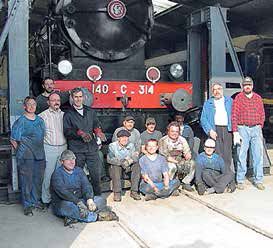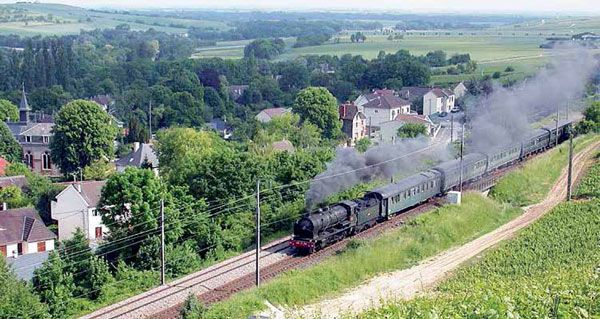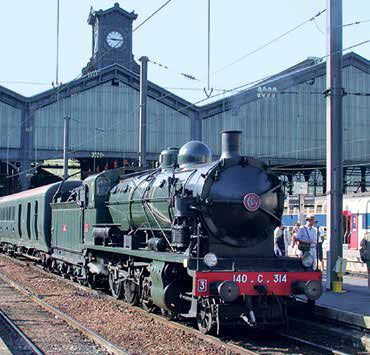Recently put back onto its wheels after being jacked up for inspection and repair, 140C314 is a 2-8-0 tender locomotive built in 1917 by North British Locomotive Co. Ltd., Glasgow, works No. 21651, for the Chemin de Fer de l’État (photo 1). She is one of a longlived and successful class, the origins of which date back to the final years of the Compagnie des chemins de fer de l’Ouest (West Railway Company) as a separate company before it was taken over (‘le rachat’ or buyback) by the Chemins de fer de l’État (State Railways) on 11 November 1908.

Photo 1
Enjoy more Model Engineer reading in the monthly magazine.
Click here to subscribe & save.
Since it mainly served agricultural districts, the Compagnie de l’Ouest was always short of money and, when faced with train weights that were becoming beyond the capacity of its 0-6-0 tender locomotives, the company decided to save money on design work by buying thirty locomotives from Henschel which were basically the same as the Italian 730 class. Introduced in 1908, the thirty locomotives of this class, numbered 4501-4530, were rather spindly, saturated two cylinder cross-compounds of no great distinction, some of which survived to be used during the Second World War.
Origins of the class
In Italy the Class 730 was developed into the superheated simple 2-8-0 of Class 740, with various derivatives. This design, some of which were also built by Henschel, was very successful and some are still in working order. Interestingly, Class 737 of the Italian State Railways, were Stanier 2-8-0 locomotives which had found their way there during the war. However, the Italian class 740 design is definitely not the same as the 140C design.
Design work on the 140C started around 1911, the locomotives having some design features in common with the État’s express and mixed traffic 4-6-0s; notably two cylinder simple propulsion, a large boiler pressed to the relatively low pressure of 12 bar, with a round topped firebox and a Schmidt superheater. The CF de l’État received 20 of these locomotives from Schneider in 1913 and 50 others also in 1913 from Schneider, based at le Creusot, and Fives-Lille based at Lille. This company still exists but has moved elsewhere. More locomotives were obtained during the First World War from Nasmyth Wilson and North British Locomotive Company. Six machines were lost at sea thanks to a torpedo. These machines were fitted with a Robinson superheater and weighed a little more than the French-built locomotives.
An additional 70 machines were obtained by the French army for hauling artillery (ALVF – Artillerie Lourde a Voies Ferrées). Following formation of the SNCF in 1938 the class was designated 140C.
The new 2-8-0’s were numbered from 140-101 onwards by the État and were built by the following builders:
| Number | Builder | Year |
| 101 to 120 | SACM Belfort | 1913 |
| 121 to 145 | Schneider Le Creusot | 1913 |
| 146 to 170 | Fives-Lille | 1913 |
| 171 to 250 | North-British (Hyde Park) | 1916 |
| 251 to 258 | Nasmyth-Wilson | 1916 |
| 259 to 270 | Nasmyth-Wilson | 1917 |
| 271 to 320 | North-British (Hyde Park) | 1917 |
| 321 to 345 | North-British (Hyde Park) | 1917/18 |
| 346 to 370 | North-British (Hyde Park) | 1917 |
The ALVF locomotives were sold after the war to the Compagnie de l’Est and the Compagnie des Chemins de fer de Paris à Lyon et à la Méditerranée (35 each). After formation of the SNCF in 1938 these ALVF locomotives were re-numbered 140C1 à 70. The AVLF locomotives were built as follows:
| Number | Builder | Year |
| 1 to 35 | North-British (Atlas Works) | 1916 |
| 36 to 46 | Vulcan Foundry | 1919 |
| 46 to 70 | Vulcan Foundry | 1920 |
Design work on the 140C started around 1911, the locomotives having some design features in common with the État’s express and mixedtraffic 4-6-0s; notably two cylinder simple propulsion, a large boiler pressed to the relatively low pressure of 12 bar.


Left: Photo 2 – Work in progress. The locomotive is well looked-after.
Right: Photo 3 – Members of the team
Preservation
Of the eight surviving locomotives (140C 22, 27, 38, 231, 287, 313, 314 and 344) all were built by North British except for No. 38 which is a Vulcan Foundry product. However, locomotives swap components and even identities so we can never be sure of these things!
Owing to their low axleload, general robustness and simplicity this class had a long life and, because some examples were hired out to the CFTA (Chemins de Fer et Transports Automobile), some survived to bring down the curtain on French steam’s normal commercial operation. For this reason, no less than eight have been preserved.
The CFTV’s example (photos 2 and 3) started her career as État No. 140-314, being landed at Saint-Nazaire and allocated first to Saint-Brieuc depot. Following formation of the SNCF she became 140C314 but remained in the Ouest Region (as shown by a figure 3 in a white box on the front buffer beam, just visible in photo 1).
As stated above, the locomotive is a two cylinder simple, with piston valves operated by Walschaearts valve gear and a bypass arrangement to permit freerunning when drifting. Plate frames were used although a number of cut-outs were used to reduce weight. The connecting rods and valve gear are of robust construction and the balance weights on the third axle are notably large as they seem to take up half the area of those main driving wheels. The locomotive is fitted with axle box wedges and compensated springing.
As with most French standard gauge steam locomotives, air brakes are used, the pump being mounted on the righthand side of the smoke box (the locomotive is left-hand drive), the locomotive and the tender being fitted with a ‘straight’ air brake. Steam heating is also fitted and, with a maximum speed of 80 kph (50mph), the locomotive is capable of performing passenger duties. Incidentally, the locomotive is fitted with a speed recorder, in this case the Flannan type.
The principal dimensions are: cylinder bore of 590mm with stroke of 650mm; wheel diameter of 1,440mm, the leading carrying wheels being of 850mm. Thanks to the Zara truck in which the front coupled wheels and the leading carrying wheels are linked together in a bogie, the locomotive is stated to be able to travel round a curve of radius 94 metres. Owing to the flexibility required by the Zara truck the crankpins of the leading coupled wheels are made so that their ends have a spherical profile. The rocking grate has an area of 3.16 square metres. The maximum axle weight is 17.2 tonnes.

Photo 4: A run to celebrate 150 years of Reims Station.
The 140C locomotives were paired with a variety of tenders. That which has been normally coupled to 140C314 is 18C428 constructed by Marine- Homécourt in 1913. This double bogie tender weighs 21.6 tonnes empty and has a capacity of 9 tonnes of coal and 18 cubic metres (about 4000 gallons) of water.
During the Second World War 140C314 was requisitioned by the Germans, being returned to France in 1950. Following repairs which included a new ‘Nord’ type smokebox door and Coale safety valves, the locomotive worked until the 1970s. The locomotive was acquired by the CFTV in 1994 and, in addition to service on the CFTV, has also made occasional forays onto the SNCF main lines on special trains and for filming purposes (photos 4 and 5).
The preserved railway The CFTV (Chemin de Fer Touristique du Vermandois/ Cercle Ferroviaire et Touristique du Vermandois) is based at St. Quentin, Aisne, some 180km from the French end of the Channel Tunnel. Activities usually take place on a weekend or during Thursday and the depot can be found in the Zone Industrielle Saint- Lazare at Saint-Quentin. The location of this depot, together with details of the CFTV can be found on the internet at: http://www.cftv.fr Note: some sections of the website are available in English language.
The Chemin de Fer Touristique du Vermandois public timetable for the rest of the season is as follows:
 Photo 5: Awaiting departure on the French main line.
Photo 5: Awaiting departure on the French main line.
Train schedule for 2013 – Departing from Saint Quentin (CFTV Depot in the Zone Industrielle St. Lazare located south of St.Quentin SNCF station; owing to track access problems CFTV trains currently do not start from the SNCF station).
27 October – Steam train with dining car option
14 and 21 December – ‘Pere Noel’ (Father Christmas) steam special with dining car option with Champagne (booking required)
- Steam trains may be assisted by a Diesel locomotive.
- All trains depart from, and return to, Saint Quentin (platform near CFTV Depot).
- Diners travelling by the ‘Steam train with Dining Car option’ should join the train at 12:50 hours (pre-booking is essential). This is so that an aperitif may be enjoyed before lunch.
- Passengers for the ‘Steam Stopping Train’ and non-dining passengers for the ‘Steam Train with Dining Car’ option should join the train at 14:15 hours at the platform near the CFTV depot.
- Please note that while the CFTV endeavour to run the trains according to the above timetable, unforeseen circumstances may entail alteration or cancellations.
- The CFTV reserves the right to vary any of the provisions of its website without prior notice.




